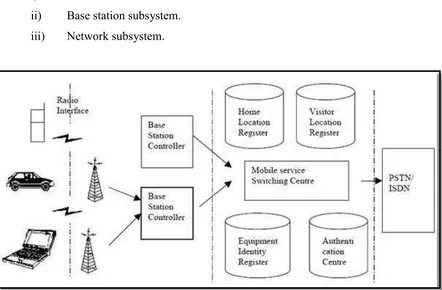UNIVERSITI TEKNIKAL MALAYSIA MELAKA
Automatic traffic light controller for ambulance
(electronic resource)
This report submitted in accordance with requirement of the Universiti Teknikal Malaysia Melaka (UTeM) for the Bachelor Degree in Mechanical Engineering Technology
(Refrigeration and Air-Conditioning System) (Hons.)
by
Siti Suhaila Jaapar Sidek
i
ABSTRAK
ii
ABSTRACT
iii
ACKNOWLEDGEMENTS
iv
DEDICATION
vi
CHAPTERN3: RESEARCH METHODOLOGY 21
3.1 Sequence of Work Project 21 3.1.1 Flowchart of the Project Thesis 22 3.1.2 Flowchart of the Project Process 23
3.2 Analysis Method 24
3.3 Application Software 26 3.3.1 MicoCode Studio (PIC Basic Pro) 26 3.3.2 Proteus Software 27
3.4 Conclusion 29
CHAPTER 4: INITIAL RESULT AND DISCUSSION 30
4.1 Schematic Circuit for Project 30 4.2 The Electronic Control System 32
4.2.1 PIC Microcontroller 32 4.2.2 Radio Frequency Module (RF Module) 33
4.3 Data Analysis 34
vii
LIST OF TABLES
1.1 New Registered Motor Vehicles by Type and State, Malaysia, 2012 1 1.2 Total Motor Vehicles by Type and State, Malaysia, 2012 2
3.1 List of Equipment for Collecting Data 25
4.1 Data Time to Detect the Signal Based On the Distance Between
Transmitter and Receiver 35 4.2 Data Time Taken to Change Traffic Light from Red to Green
viii 3.5 Workspace of MicroCode Studio-PIC Basic Pro 27
3.6 Proteus Launcher 28
4.1 Traffic Light Schematic Circuit 30 4.2 RF Module (Transmitter) Schematic Circuit 31 4.3 RF Module (Receiver) Schematic Circuit 31 4.4 PIC16F877 Pin Diagram 32 4.5 PIC Microcontroller with Traffic Light Circuit 33 4.6 RF Transmitter Module 33 4.7 RF Receiver Module 34 4.8 Graph Distance between Transmitter and Receiver Vs
Time Detection Signal 35
4.9 Graph Distance between Transmitter and Receiver Vs
ix
LIST OF ABBREVIATIONS, SYMBOLS AND
NOMENCLATURE
FDMA - Frequency Division Multiple Access GPRS - General Packet Radio Service
GSM - Global System for Mobile Communications IC - Integrated Circuit
I/O - Input / Output
ISDN - Integrated Services Digital Network
ISM Band - Industrial, Scientific and Medical Radio Band LED - Light Emitting Diode
OSS - Operations Support System PCB - Printed Circuit Board
PIC - Peripheral Interface Controller PSTN - Public Switched Telephone Network RF - Radio Frequency
RFID - Radio Frequency Identification Rx - Receiver
SHF - Super High Frequency
TDMA - Time Division Multiple Access Tx - Transmitter
1
CHAPTER 1
INTRODUCTION
This section basically briefs the background of traffic system. It is including the statistic the rapid of vehicles and history of traffic light as a control system. This chapter also state about the objective, problem statement and also the work scope of this project.
1.1 Background
2
Table 1.1: New registered motor vehicles by type and state, Malaysia, 2012
Table 1.2: Total motor vehicles by type and state, Malaysia, 2012
3 One of the tools that are currently used to control of vehicle traffic is traffic lights. Traffic lights show the right of way to road users when it safe to cross by displaying lights of a standard color following a universal color code for that place (Jianhua, 2009). In Malaysia, there have commonly three of main light, red, yellow, and green. The red signal prohibits any traffic from proceed the crossing or movement, the yellow light denoting prepare to stop at the intersection and the green light allows traffic to proceed in the direction denoted.
The first historical of traffic light came into creature before the automobile was in use, and traffic consisted only of pedestrians, buggies, and wagons. Installed at an crossroads in London in 1868, it was a device had lights and it used arms which extended outwards. It was operated manually by a police officer . The signal was 22 feet high and crowned with a gas light with red and green signals. Red meant "stop" and green meant "caution". The light, illuminated by gas, was turned by means of a lever at its base so that the suitable light faced traffic. On January 2, 1869, this crude traffic light exploded, injuring the policeman who was operating it.
After the coming of automobiles, the situation got even worse. Police Officer William L. Potts of Detroit, Michigan, decided to do something about the problem. What he had in mind was figuring out a way to adapt railroad signals for street use. The railroads were already utilizing automatic controls. But railroad traffic traveled along parallel lines. Street traffic traveled at right angles. Potts used red, amber, and green railroad lights and about thirty-seven dollars worth of wire and electrical controls to make the world’s first 4-way three color traffic light (Pollard, 2008). It was installed in 1920 on the corner of Woodward and Michigan Avenues in Detroit.
4 Corporation and provided the protection they needed to begin building a monopoly on traffic light manufacture.
As computers started to evolve, traffic light control also advanced computers that were better at vehicle detection (McShane, 1999). The computers maintained control over 159 signals in the cities through telephone lines. People praised the computers for their detection abilities. Thanks to detection computers could change the length of the green light based on the volume of waiting cars. The rise of computers is the model of traffic control which is now used in the 21st century.
5 Due to the rapid increase of vehicles, congestion often occurs. But congestion at the traffic light causes emergency vehicles such as ambulances are not able to pass through the intersection immediately could be avoided if a traffic light has a control system.
Automatic traffic light controller for ambulance using PIC is a project to program priority based traffic light controller for ambulance. During an emergency situation at traffic light junctions, the ambulance can trigger the traffic light to change from red to green to make path for its way. If the traffic light shows green, the time duration will be delayed until the ambulance finishes crossing the road. The signal will be send using RF link. The traffic light operation turns back to normal when ambulance finishes crossing the road.
1.2 Objective
The purpose of the project is to be able to design a system that can trigger the traffic light from red to green when ambulance is in emergency situation. The other purpose is to analyze the system in terms of reception of distances and delay measurement.
1.3 Problem Statement
6
1.4 Work Scope
This project used RF link to transmit and receive signal. The traffic light also need to be change to green when ambulance reach near to the traffic signal (approximately 100 meter). This project also used PIC microcontroller 16F877 as a main role of this project. The maximum range for RF detection in this project is around 60 meters.
1.5 Conclusion
7
CHAPTER 2
LITERATURE REVIEW
A lot of studies have been made for this project, Automatic Traffic Light Controller for Ambulance. These studies are mostly from the journals, conference papers and books. This chapter will discuss the current traffic condition, type of traffic light that had been used, the available wireless systems also the one used in this project and the programming language that used involved in this project to design the system that can control and trigger the traffic light at path of ambulance during an emergency situation.
2.1 Traffic Congestion
8 Figure 2.1: Traffic congestion condition
A market research by Frost and Sullivan on 1,227 respondents in Kuala Lumpur has revealed that 41% of the respondents ranked traffic jam and congestion as their number one frustrations, higher than Asia-Pacific's average of 35% and global average of 29% (Bernama, 2014). Kuala Lumpur is also was bound to face challenges of congestion ahead as car ownerships continued to grow.
Traffic research still cannot fully predict under which conditions a "traffic jam" as opposed to heavy, but smoothly flowing traffic may suddenly occur. It has been found that individual incidents such as accidents or even a single car braking heavily in a previously smooth flow may cause ripple effects (a cascading failure) which then spread out and create a sustained traffic jam when, otherwise, normal flow might have continued for some time longer.
9 Traffic congestion give the negative effects to people such as wasting time, fuel, make a delay in user daily business planning which may result in late arrival for employment, meetings, and education, resulting in lost business, disciplinary action or other personal losses. It is also cause of inability to forecast travel time accurately and can bring the stressed and frustrated to driver or passenger. Traffic congestion also gives the problem to user when in emergencies time. Blocked traffic may interfere with the passage of emergency vehicles traveling to their destinations where they are urgently needed.
2.2 Type of Traffic Light
One of the main advantages of traffic light is that it minimizes the conflict points within an intersection by sharing the available time between competing traffic streams. Based on statistic road crashes in Malaysia in 2006 stood that the number of road accidents was 341,232 and this resulted in 6,287 deaths among road users. This numbers are considered high for a population of 26,640,000 giving an index of 23.5 road fatalities per 100,000 inhabitants. One of the possible reasons for the high number of crashes and injuries is due to beating traffic lights. The problem of increased vehicular flow on the road also increases the traffic congestion. There is an urgent need to optimize traffic control to accommodate the increase in vehicles in urban traffic which experience long travel times due to inefficient traffic light control especially to avoid a delay time for ambulance to arrive at the destination during emergency. There are several types of conventional methods of traffic light control:
10 The most common is the pre-timed traffic light with the signal timing cycle length usually falling between 45 and 120 seconds. The timing for each signal is determined based on traffic volume and traffic patterns in each particular area. The second type is a traffic light with a countdown timer. It is a digit time indicator, placed on the pole above the traffic signal. Its purpose is to reduce congestion at traffic junctions, help motorists to have a better understanding of the traffic flow and helps motorists to be aware of the remaining time left on the green phase. Traffic signal systems are designed to maximize the capacity of junctions whilst maintaining an operating environment which is as safe as possible.
Figure 2.2: Traffic light with countdown timer
11
2.3 Wireless Transmission
The wireless transmission data that will been used is Radio Frequency (RF) to transmit and receive data but there are also have some other wireless technology that can be used such as GSM, Bluetooth and Wi-Fi.
2.3.1 Global System for Mobile Communications (GSM)
GSM is a cellular network, which means that cell phones connect to it by searching for cells in the immediate vicinity. The coverage area of each cell varies according to the implementation environment (Mouly & Pautet, 2002). For example, macro cells can be regarded as cells where the base station antenna is installed on a mast or a building above average rooftop level. The network is structured into a number of discrete sections:
Base Station Subsystem – the base stations and their controllers explained.
Network and Switching Subsystem – the part of the network most similar to a fixed network, sometimes just called the "core network".
GPRS Core Network – the optional part which allows packet-based Internet connections.
Operations support system (OSS) – network maintenance.
12 GSM networks operate in a number of different carrier frequency ranges, GSM frequency ranges for 2G and UMTS frequency bands for 3G. Most 2G GSM networks operating in the 900 MHz or 1800 MHz bands (Timo, et al., 2004). Where these bands were already allocated, the 850 MHz and 1900 MHz bands were used instead for example in Canada and the United States. In rare cases the 400 and 450 MHz frequency bands are assigned in some countries because they were previously used for first-generation systems (Sanjay, et al., 2008).
GSM uses Frequency Division Multiplexing and Time Division Multiplexing. FDMA divides the frequency ranges for GSM, which are 890-915, 935-960 and some others that the book didn't have. Each is divided into 200 kHz wide channels. As far as TDMA goes, each time slot is 577 micro seconds long, 8 time slices is a frame, lasting for a grand total of 4.615ms. A multi frame consists of 51 frames, 51 multi frames make up a Super frame, and 2048 Super frames make a Hyper frame which is 2715648 frames (Sarika, 2013). The GSM network can be divided into three parts to illustrate this, consider figure 2.2:
i) Mobile station.
ii) Base station subsystem. iii) Network subsystem.
13
2.3.2 Bluetooth and Wi-Fi
Another wireless technology is Bluetooth and Wi-Fi. Bluetooth is a wireless technology standard for exchanging data over short distances using short-wavelength UHF radio waves in the ISM band from 2.4 to 2.485 GHz from fixed and mobile devices, and building personal area networks (PANs). It was originally conceived as a wireless alternative to RS-232 data cables. It can connect several devices, overcoming problems of synchronization. Bluetooth operates in the range of 2400– 2483.5 MHz (including guard bands).
Wi-Fi is a technology that allows an electronic device to exchange data or connect to the internet wirelessly using 2.4 GHz UHF and 5 GHz SHF radio waves. These can connect to a network resource such as the Internet via a wireless network access point. Such an access point (or hotspot) has a range of about 20 meters (66 feet) indoors and a greater range outdoors. Hotspot coverage can comprise an area as small as a single room with walls that block radio waves, or as large as many square kilometers achieved by using multiple overlapping access points.
14
2.3.3 Radio Frequency (RF)
Radio Frequency (RF) communications is based on laws of physics that describe the behavior of electromagnetic energy waves. RF is a rate of oscillation in the range of around 3KHz to 300 GHz, which corresponds to the frequency of radio waves, and the alternating currents which carry radio signals. RF usually refers to electrical rather than mechanical oscillations. There are essentially parameters to look at when trying to determine range:
(i) Transmit power
Transmit power refers to the amount of RF power has comes out of the antenna port of the radio. Transmit power is usually measured in Watts, miliwatts or dB.
(ii) Receiver sensitivity
Receiver sensitivity refers to the minimum level signal the radio can demodulate. It is convenient to use an example with sound wave; transmit power is how loud someone is yelling and receive sensitivity would be how soft a voice someone can hear. Transmit power and receive sensitivity together constitute between the transmitter and receiver and still have communication occur.
(iii) RF communications and data rate



